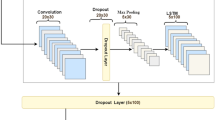Abstract
COVID-19 has caused physical, emotional, and psychological distress for people. Due to COVID-19 norms, people were restricted to their homes and could not interact with other people, due to which they turned to social media to express their state of mind. In this paper, we implemented a system using TensorFlow, which consists of multilayer perceptron (MLP), convolutional neural networks (CNN), and long short-term memory (LSTM), which works on preprocessing, semantic information on our manually extracted dataset using Twint scraper. The models were used for classifying tweets, based upon whether they indicate depressive behavior or not. We experimented for different optimizer algorithms and their related hyperparameters for all the models. The highest accuracy was achieved by MLP using sentence embeddings, which gave an accuracy of 94% over 50 epochs, closely followed by the other two.
Access this chapter
Tax calculation will be finalised at checkout
Purchases are for personal use only
Similar content being viewed by others
References
World Health Organization. Depression. https://www.who.int/news-room/fact-sheets/detail/depression. Accessed 28 June 2021
You are what you tweet—towards data science, medium. https://towardsdatascience.com/you-are-what-you-tweet-7e23fb84f4ed. Accessed 27 June 2021
World happiness report 2021. https://worldhappiness.report/ed/2021/. Accessed 24 June 2021
200 million tweets per day. https://blog.twitter.com/en_us/a/2011/200-million-tweets-per-day. Accessed 30 June 2021
Monitoring tweets for depression to detect at-risk users. https://ruor.uottawa.ca/bitstream/10393/36030/1/Jamil_Zunaira_2017_thesis.pdf. Accessed 29 June 2021
Depressive moods of users portrayed in Twitter. https://nyuscholars.nyu.edu/ws/portalfiles/portal/90894123/depressive_moods_kdd.pdf. Accessed 28 June 2021
AlSagri H, Ykhlef M (2020) Machine learning-based approach for depression detection in Twitter using content and activity features. IEICE Trans Inf Syst E103.D(8):1825–1832. https://doi.org/10.1587/transinf.2020EDP7023
Islam MR, Kabir MA, Ahmed A, Kamal ARM, Wang H, Ulhaq A (2018) Depression detection from social network data using machine learning techniques. Health Inf Sci Syst 6. https://doi.org/10.1007/2Fs13755-018-0046-0
Detecting depression through tweets. https://web.stanford.edu/class/archive/cs/cs224n/cs224n.1184/reports/6879557.pdf. Accessed 28 June 2021
Orabi AH, Buddhitha P, Orabi MH, Inkpen D (2018) Deep learning for depression detection of Twitter users. Int J Comput Linguist Appl 88–97. https://doi.org/10.18653/v1/W18-0609
Wen S. Detecting depression from tweets with neural language processing. J Phys Conf Ser 1792. https://doi.org/10.1088/1742-6596/1792/1/012058
Maigrot C, Bringay S, Azé J (2016) Concept drift vs suicide: how one can help prevent the other? Int J Comput Linguist Appl
Hochreiter S, Schmidhuber J (1997) Long short-term memory. Neural Comput 1735–1780. https://doi.org/10.1162/neco.1997.9.8.1735
Kim Y (2014) Convolutional neural networks for sentence classification. In: Proceedings of the 2014 conference on empirical methods in natural language processing (EMNLP), pp 1746–1751. https://doi.org/10.3115/v1/D14-1181
Pennington J, Socher R, Manning C (2014) Global vectors for word representation. In: Proceedings of the 2014 conference on empirical methods in natural language processing (EMNLP), pp 1532–1543. https://doi.org/10.3115/v1/D14-1162
Author information
Authors and Affiliations
Corresponding author
Editor information
Editors and Affiliations
Rights and permissions
Copyright information
© 2023 The Author(s), under exclusive license to Springer Nature Singapore Pte Ltd.
About this paper
Cite this paper
Kuber, A., Kulthe, S., Kosamkar, P. (2023). Detecting Depression in Tweets Using Natural Language Processing and Deep Learning. In: Joshi, A., Mahmud, M., Ragel, R.G. (eds) Information and Communication Technology for Competitive Strategies (ICTCS 2021). Lecture Notes in Networks and Systems, vol 400. Springer, Singapore. https://doi.org/10.1007/978-981-19-0095-2_43
Download citation
DOI: https://doi.org/10.1007/978-981-19-0095-2_43
Published:
Publisher Name: Springer, Singapore
Print ISBN: 978-981-19-0094-5
Online ISBN: 978-981-19-0095-2
eBook Packages: EngineeringEngineering (R0)




